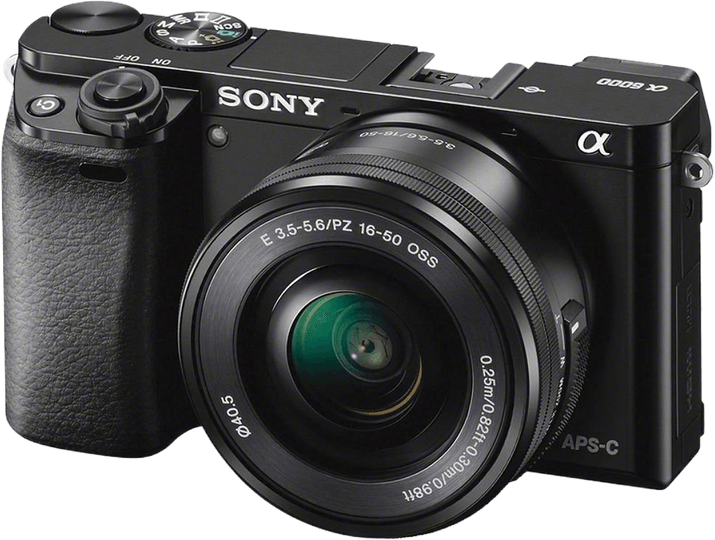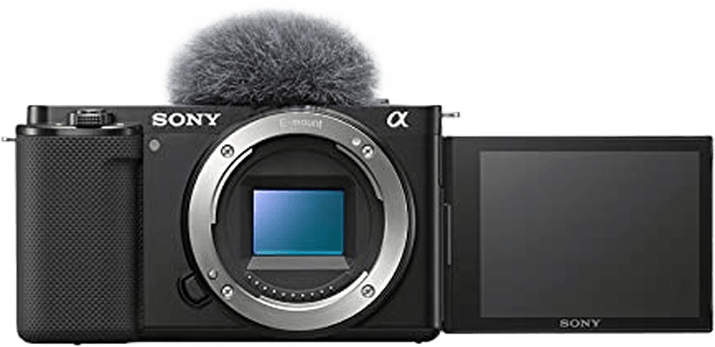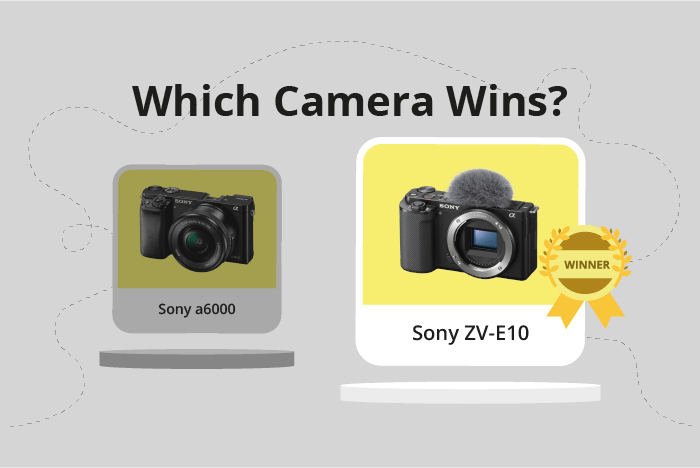Sony a6000 vs ZV-E10 Comparison
Sony a6000

Sony ZV-E10

The Sony ZV-E10 emerges as the winner with a score of 65/100, while the Sony a6000 trails behind at 57/100. Both cameras share the mirrorless category, and their dimensions and weight are nearly identical, with the ZV-E10 slightly smaller at 115 x 64 x 45mm and weighing 343g, compared to the a6000’s 120 x 67 x 45mm and 344g.
The ZV-E10 outperforms the a6000 due to its more recent release in 2021 and a lower launch price of $700, as opposed to the a6000’s 2014 release and $799 price tag. However, the a6000 still has its merits, offering a solid performance for a camera released seven years earlier. Both cameras deliver quality results, but the ZV-E10’s updated features and affordability give it the edge over the a6000.
Sony a6000 vs ZV-E10 Overview and Optics
The Sony ZV-E10 wins in the optics comparison with a score of 69/100, while the Sony a6000 scores 67/100. Both cameras have several similarities in their specifications. They share the same shooting speed of 11 frames per second, sensor type (CMOS), processor (Bionz X), sensor size (APS-C), lens mount (Sony E), and lack of image stabilization. The aspect ratio differs, with the a6000 using 3:2 and the ZV-E10 using 4:3.
The ZV-E10 has a slight edge over the a6000, primarily due to its higher DXOMARK score for the sensor, 86 compared to the a6000’s 82. This higher score means the ZV-E10 has a better sensor performance, which can result in improved image quality. However, the difference in megapixels is minimal, with the a6000 having 24.3 megapixels and the ZV-E10 having 24 megapixels. This small difference is unlikely to have a significant impact on image quality.
On the other hand, the a6000 has a minor advantage in megapixels, which could provide slightly more detail in images. However, considering the overall optics scores and other specifications, this advantage is not enough to make the a6000 a better choice in terms of optics.
In comparing the optics of the Sony a6000 and the Sony ZV-E10, the ZV-E10 takes the lead due to its better sensor performance. The a6000’s slightly higher megapixel count does not outweigh the advantages provided by the ZV-E10’s superior sensor. Therefore, the Sony ZV-E10 is the better choice for those prioritizing optics performance.
Sony a6000 vs ZV-E10 Video Performance
The Sony ZV-E10 outperforms the Sony a6000 in video capabilities, boasting a 91/100 video score compared to the a6000’s 56/100. Both cameras share some common features, such as Full HD video resolution and a maximum video dimension of 1920 x 1080. However, the ZV-E10 takes the lead with its superior specifications, offering 4K video resolution and a maximum video dimension of 3840 x 1920. Additionally, the ZV-E10 provides a significantly higher maximum video frame rate at 120fps, double the a6000’s 60fps.
A standout feature of the Sony ZV-E10 is its built-in time-lapse functionality, which the a6000 lacks. This allows the ZV-E10 to capture stunning time-lapse videos without the need for additional software or equipment. The combination of 4K resolution, higher frame rate, and time-lapse functionality makes the ZV-E10 a more versatile and powerful camera for videography.
While the Sony a6000 falls short in comparison to the ZV-E10’s video capabilities, it still offers solid performance with Full HD resolution and a 60fps frame rate. This may be sufficient for casual users or those with less demanding video needs. However, for those seeking professional-quality video and advanced features, the ZV-E10 is the clear winner.
Considering the substantial difference in video scores and the ZV-E10’s superior specifications, it is evident that the Sony ZV-E10 excels in video capabilities compared to the Sony a6000. The a6000 provides a decent performance for casual users, but the ZV-E10 offers a more powerful and versatile option for those seeking to capture high-quality video content.
Sony a6000 vs ZV-E10 Features and Benefits
The Sony ZV-E10 emerges as the winner in the features comparison with a score of 68/100, while the Sony a6000 scores 41/100. Both cameras share some specifications, including a 3-inch screen size, no GPS, and WIFI connectivity. However, the ZV-E10 outperforms the a6000 in several aspects, making it a better choice for many users.
The ZV-E10 has a touchscreen, which the a6000 lacks, providing a more user-friendly and intuitive experience. Additionally, both cameras have flip screens, but the ZV-E10’s screen resolution is slightly higher at 920,000 dots compared to the a6000’s 921,600 dots. This difference in resolution results in a marginally better image display on the ZV-E10. Furthermore, the ZV-E10 has Bluetooth connectivity, which the a6000 does not offer. This feature allows for seamless connection and data transfer between the camera and other devices.
The a6000 does not have any significant advantages over the ZV-E10 in terms of features. Its lower score reflects its fewer and less advanced features compared to the ZV-E10. However, some users might still prefer the a6000 due to factors such as price, personal preferences, or specific use cases where its features are sufficient.
Comparing the features of the Sony a6000 and the Sony ZV-E10 reveals that the ZV-E10 is a more advanced and user-friendly camera. Its touchscreen, higher screen resolution, and Bluetooth connectivity make it a better choice for users seeking a versatile and feature-rich camera. On the other hand, the a6000 may be suitable for those who prioritize price or have specific needs that the camera’s features can meet.
Sony a6000 vs ZV-E10 Storage and Battery
The Sony ZV-E10 wins in storage and battery with a score of 24/100, compared to the Sony a6000’s score of 21/100. Both cameras share common specifications such as having one memory card slot and accepting SD/SDHC/SDXC and Memory Stick Pro Duo cards. They also use the same battery type, NP-FW50, and lack USB charging capabilities.
The ZV-E10 outperforms the a6000 in battery life, providing 440 shots compared to the a6000’s 360 shots. This advantage makes the ZV-E10 more reliable for extended shooting sessions. The a6000 does not offer any advantages over the ZV-E10 in terms of storage and battery.
Considering these factors, the Sony ZV-E10 proves to be a better choice for users prioritizing storage and battery performance. The extended battery life ensures longer shooting time, making it a more practical option for various photography and videography situations.
Sony a6000 vs ZV-E10 – Our Verdict
Are you still undecided about which camera is right for you? Have a look at these popular comparisons that feature the Sony a6000 or the Sony ZV-E10:

